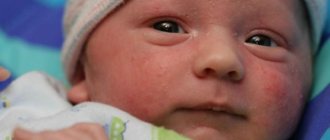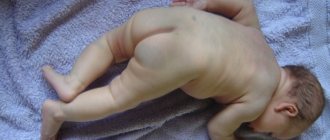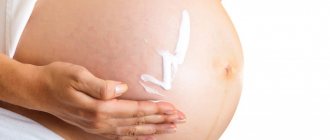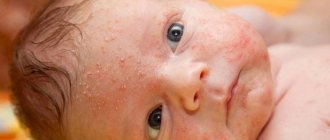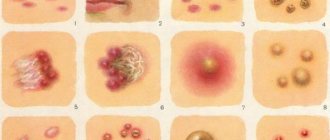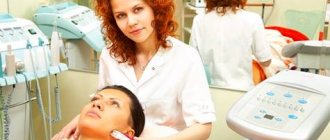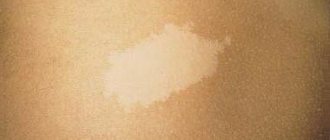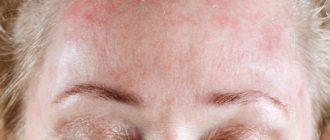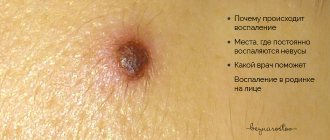A rash on a newborn’s body can appear for various reasons, ranging from banal food allergies, prickly heat, to a serious infection in the child’s body . Rashes on the body of a beloved child are a serious cause for concern for the mother.
Important. A rash on the body of newborn babies may indicate functional disorders in the child’s body or be a sign of infectious or viral diseases. Therefore, it is important not only to understand the main types of rashes, but also to establish the root cause of the dermatological problem.
Rash in newborn babies, which can occur for a variety of reasons, is a serious cause for concern for parents.
We recommend studying this topic:
Causes of allergic rashes in children and methods of treating rashes
4623
0
0
reading information
When does a newborn's rash need treatment?
A rash is an accumulation of pathological elements on the skin or mucous membranes. They differ from normal skin in appearance, texture, and color. The elements of the rash consist of blisters, papules, blisters, and spots.
Doctors say that a rash on a child’s body does not always require special treatment. Since the appearance of skin rashes itself has various causes, childhood rashes are divided into the following types:
- acne (hormonal rash of newborns);
- prickly heat;
- hives;
- allergic rash;
- diaper dermatitis;
- atopic dermatitis.
Parents may also be concerned about the usual redness of the skin of a baby who has just been born. This is an absolutely normal reaction associated with imperfect thermoregulation of the baby. Slight peeling on the body and face of a newborn should also not alarm you; it does not require any treatment.
Rash on the face of a newborn
An infant's skin is very sensitive. A rash on the face of a newborn may appear due to poor nutrition of the mother, dampness or dryness in the apartment, hormonal changes, allergic reactions, and so on. If the child is allergic, you only need to wash the clothes with baby powder and iron them on both sides, do not use cosmetics, lubricating the child’s folds only with baby cream. Allergic rashes can be caused by artificial mixtures. Therefore, you need to select them very carefully.
The immune system of a newborn is very weak; walks in the fresh air and breast milk can strengthen it. Therefore, every woman should try to hold out breastfeeding for at least six months. In order for milk to be healthy and not cause allergies, a young mother must strictly monitor what she eats. Only fresh foods that do not cause gas formation and indigestion in the child, rich in vitamins and minerals, should be in the diet of a nursing woman.
Any rash on the face of a newborn cannot appear in the first days of life. Various plaques, papules, blisters, blisters, spots and much more can stain delicate cheeks and make a lasting impression on parents. There are about a dozen reasons for such manifestations. Indeed, in the first days of life, the baby tries with all his might to adapt to the external environment. If recently he was reliably protected in the womb, now he is obliged to cope with all problems on his own. For most children, the rash does not pose any danger, as it appears due to natural causes.
Rash in newborns can occur as a result of:
- maternal malnutrition;
- dermatitis: contact, diaper or atopic;
- hives;
- prickly heat;
- infections;
- neonatal changes;
- reactions to medications;
- insect bites;
- reactions to cosmetic preparations.
A neonatologist or pediatrician will help you figure out the root cause of such manifestations. Dermatitis can be cured quite simply if you address the problem in time. A rash on the face of a newborn appears in 80% of cases and it is not a reason for panic if the parents do not have a predisposition to allergies.
Some features of newborn acne
Newborn acne looks slightly different than adult acne. Most often it appears when the child is only a few days old. The rash looks like small bright pink pimples, inside of which a white substance is visible. Acne of newborns has several names - hormonal rash, milia, neonatal pustulosis.
One of the names - hormonal rash - makes it clear what the cause of these skin manifestations is. These are ordinary hormonal changes, the adaptation of the baby’s body to new living conditions, and the cleansing of the mother’s hormones from the blood.
Acne can also be caused by local accumulation of yeast fungus. This is also not considered a pathology; any person has such a fungus. Areas where neonatal pustulosis most often breaks out: upper back, neck, head, face.
Acne does not require treatment; at the age of three months the skin stops blooming without any intervention. Recommendations for parents: do not squeeze pimples under any circumstances, follow all hygiene rules regarding caring for a newborn.
What is prickly heat
It is not without reason that they say that the temperature in a child’s room should not exceed +22 C. If this condition is not met, the child will certainly sweat a lot. As a result, a small pink rash may appear on the baby's skin, in the folds of the chest and neck, and under the armpits.
The affected area appears slightly swollen. Skin rashes of this kind in children can occur throughout the first year of life. Most often, it does not cause any discomfort to the child. To make prickly heat go away faster, treat the affected areas with baby powder.
Let us recall the reasons why prickly heat appears:
- The temperature in the children's room is too high.
- Failure to comply with the ventilation schedule for the room where the child is located.
- The desire to unnecessarily wrap the baby in warm clothes.
- Insufficient hygiene towards the child.
Parents need to eliminate these causes; soon the baby’s skin will lose its swelling and redness.
Rash on the head of a newborn
The dermis on a child’s head is especially delicate and needs careful care. Only often a rash on the head of a newborn appears suddenly and requires special care. On the under-hair part of the head, keratinized yellow scales appear, flaking and causing unprecedented discomfort to the baby. Seborrheic dermatitis is not a big problem. The sebaceous glands have not yet begun to work at full capacity and they need help. Although the problem will be more difficult to cope with if seborrhea is of a fungal nature. For these purposes, in order to avoid aggravating the situation, you need to purchase a soft brush and carefully comb out the scales from your hair. During the bathing process, try not only to rinse your hair as much as possible, but also to remove scales. After the daily toilet, you need to thoroughly rub in boiled sunflower oil or special oils sold in pharmacies. Within a month the problem can be easily dealt with.
What does hives look like?
This disease has a telling name. The rashes on the baby's body look exactly like a severe burn caused by nettles. The rash is accompanied by obsessive itching. Subsequently, the rash transforms into blisters of different sizes and shapes, affecting the face, head, and body. Urticaria is a severe form of skin allergy that can quickly progress to Quincke's edema.
If you suspect your baby has hives, call a doctor immediately. The disease is the body’s reaction to an allergen - food or household; it can go away on its own, but in no case is it worth the risk.
You should be wary of Quincke's edema - a dangerous complication of urticaria, which causes suffocation. The latter can lead to serious consequences.
Causes of urticaria:
- hypothermia;
- exposure to heat;
- exposure to the scorching sun;
- consequences of severe stress;
- friction from elastic bands on clothes, from car seat straps;
- past infectious disease;
- the presence of helminths in the baby’s body.
After making a diagnosis, the doctor prescribes medications that eliminate allergic manifestations.
To relieve severe itching, you will need special ointments, which will also be prescribed by your doctor. If the disease is very severe, hormonal ointments will provide effective help.
Rash on the cheeks of a newborn
A baby's cheeks are one of the most common places where rashes appear. They can be caused by various reasons and pass either without outside intervention or under the close supervision of a doctor.
- Acne initially looks like a rash on the cheeks of a newborn. Within 2-3 days, it degenerates into pustules that acquire pink, red and purple colors. In this case, you should not worry, as this is a natural adaptation of the baby to the external environment. When the child is 2-4 months old, it all depends on the individual characteristics; the rash will disappear on its own.
- Ritter's disease initially appears as a concentration of many small blisters with purulent contents located around the mouth. Every day it spreads more and more and can spread not only over the entire surface of the dermis of the head, but also creep onto the body. A rash of this nature in newborns is of an allergic or infectious nature. You cannot get rid of it without the intervention of a pediatrician. As soon as recovery occurs, the skin begins to gradually peel off. In this case, the dermis comes off in strips, in the place of which, after 2-3 weeks, absolutely healthy skin appears.
- Diathesis occurs in 50% of children in the first months of life. It can be caused not only by dietary errors, disruption of the normal functioning of the gastrointestinal tract, diseases of the nervous system or severe excitability, but also by allergies to both food and external irritants. Depending on the main cause that provoked the disease, treatment is prescribed.
- Cysts or malfunction of the excretory system. In the first months of life, the sebaceous glands cannot yet function properly. This leads to the widespread formation of small white and yellow wen. They can be concentrated on both the cheeks and the arms. As soon as normal functioning of all metabolic processes is established in the child’s body, they will disappear by themselves. A similar rash in newborns is not dangerous and goes away by a maximum of 6 months.
Rash on the cheeks of a newborn has a different nature, but getting rid of it is quite simple. Often the baby copes with this problem on his own, and caring parents can only watch the baby’s efforts.
Allergic rash in babies
There are several types of allergic rashes in children, including:
- food allergies;
- household (contact) allergies;
- drug allergy.
Food allergies are:
- many small pink or red pimples;
- red, scaly patches of skin.
These manifestations of food allergies most often appear on the face, but can also appear on the legs, forearms, back, and abdomen. This is how the child’s body reacts to food (formula, complementary foods, cereals) or to food from the diet of a nursing mother.
Complementary feeding should be introduced no earlier than 4-6 months of age, gradually, consistently, carefully observing the child’s reaction to foods.
Mothers should exclude honey, sweets, chocolate, whole cow's milk, smoked meats, canned food, and citrus fruits from their menu. If the intake of the allergen is not stopped in time, as well as in case of significant allergic poisoning, the child’s rash can turn into a weeping scab.
Household (contact) allergies look like rubbing or red spots with a small rash. Its causes are a mechanical effect on the baby’s delicate skin. Allergens can be: washing powders, fabric softeners, synthetics, hard woolen textiles, dust, pet hair.
Particular attention should be paid to children's cosmetics (shampoos, foams, creams, soaps), which do not at all guarantee the absence of various side effects.
An allergy to medications consists of multiple rashes of small red spots that form anywhere. Allergens can be hormonal drugs, antibiotics, sweet syrups.
The pediatrician must replace (cancel) the inappropriate medication and prescribe a comprehensive blood test to identify allergens. Sweet syrups are replaced with neutral suppositories.
Baby's skin: rash
A wide variety of rashes can appear on a child's skin; fortunately, most types of rashes are harmless and can go away on their own.
Watch the slideshow: Taking care of your baby's skin
Types of rashes in newborns
- Pink pimples (“neonatal acne”) often appear due to the fact that the baby was exposed to maternal hormones in the womb.
| There is no need for treatment, everything will go away with time. |
Redness may remain on your baby's skin for several weeks or even months.
- Erythema toxicum is another type of rash in newborns. These pimples look like mosquito bites or hives. The cause of such rashes is unknown. They disappear on their own after a few days or weeks.
- Dry, flaky skin is most often the result of the baby being born a little later than expected. Beneath the flaky skin is normal, soft, moist skin.
- Small white bumps on the nose and face (“milia”) are caused by clogged sebaceous glands.
| As your baby's sebaceous glands enlarge and unclog after a few days or weeks, the swelling will disappear. |
- Salmon spots (this type of rash is also called "stork bite" if the rash appears on the back of the neck, or "angel's kiss" if the rash appears between the eyes) is the result of normal blockage of blood vessels (probably due to maternal hormones).
| They go away on their own after a few weeks or months; in rare cases, the stork bite will remain for life. |
- Jaundice is a yellowing of the baby's skin and eyes.
| Jaundice is caused by an excess of bilirubin (a breakdown product of blood cells). |
If the bilirubin concentration is extremely high, you can shine a blue or white lamp on the baby to reduce the bilirubin level. Excessive amounts of bilirubin can be life-threatening.
- Mongolian spots often appear anywhere on the body in children with dark skin. They are flat, blue-gray in color (look almost like bruises), and can be small or large.
| They arose as a result of the action of skin pigment that did not enter the skin when it was formed. |
These spots are harmless and usually disappear by preschool age.
After the first few days or weeks (or even months), a new rash may appear.
The most common types of rashes in the first months of a child's life
Seborrheic dermatitis in a newborn (“seborrhea”) often appears at the age of 1-2 months. Oily, yellowish crusts appear on the scalp (due to excess oil), and can be accompanied by red irritation on the face, behind the ears, on the neck and even on the palms of the hands. Depending on the symptoms, the doctor will prescribe appropriate treatment for your child.
Eczema is red, itchy patches on the skin, often on the stomach, arms, legs, elbows and behind the knees. They occur due to dry, sensitive skin, and sometimes due to allergies (although at this age it is very difficult to determine what the allergy may be).
| Your pediatrician can determine whether the rash is eczema and prescribe appropriate treatment. Typically treatment consists of: |
- Using gentle soap
- Using a gentle washing powder and not using a softener when washing children's clothes.
- Applying a steroid cream (such as hydrocortisone or something stronger) if the eczema does not go away.
- Miliaria are small red spots, most often in places that overheat and sweat, for example, the neck, the place where the body comes into contact with diapers, and the palms of the hands. Treatment consists of keeping the inflamed area dry and avoiding overheating by wearing loose clothing.
- Fungal (“monilia”) infection can manifest itself in a child in different ways. On the tongue, these rashes are called stomatitis and look like dried milk, but unlike milk they cannot be wiped off. In the diaper area, the rash appears as a profuse red rash, often with smaller pimples around the rash ("satellites"). Fungi thrive in dark, damp places, which is why you may find rashes in the creases of your thighs (as opposed to irritations that don't appear in the creases of your thighs). Fungal infections are treated with antifungal liquid medication (canker sores) or antifungal cream (for diaper areas), or both.
Tips for parents
In the first months of life, in case of any rash accompanied by other symptoms (for example, fever, poor appetite, lethargy, cough), the child should be shown to a doctor.
Reasons to be concerned about your baby's rash
And although most rashes are not dangerous, you need to be especially careful about some of them:
- Water blisters (especially if the fluid is cloudy or yellowish) can signal a serious infection, such as a bacterial infection or herpes.
- Small red or purplish spots throughout the body ("petechiae") may be caused by a viral infection or a potentially dangerous bacterial infection. When pressed, the spots do not turn white. Any child with such spots should be seen by a doctor immediately.
Diaper dermatitis
Symptoms of diaper dermatitis include blisters, redness, and peeling that appear only in the diaper area. The causes of diaper dermatitis are prolonged contact of the skin with wet fabric and folds in diapers. Diaper dermatitis is not an allergy and does not require the use of antiallergic drugs. Treatment of diaper dermatitis consists of organizing proper care and timely changing of diapers.
Before changing the diaper, the baby must be washed with warm water and baby soap. Replacing washing with wiping with wet wipes is not the best solution. Do not forget about regular air baths, with the help of which the manifestations of diaper dermatitis will quickly disappear.
To heal diaper rash, cracks, and weeping sores, you can use special healing ointments. It is necessary to treat diaper dermatitis, since it can be associated with a bacterial infection.
Atopic dermatitis
The pathology consists of peeling, blistering rashes on the skin, on the cheeks, arms, buttocks, and the inside of the legs. The rashes are characterized by itching and can coalesce, forming crusts. This is an allergic manifestation to cold, wind, or certain foods.
Atopic dermatitis is often accompanied by inflammation of the tonsils and adenoids. A course of treatment is prescribed: antiallergic drugs, ointments, creams, medicinal baths are prescribed. However, medications only relieve itching. To get rid of atopic dermatitis, allergenic foods should be identified and excluded from the diet of the child and nursing mother.
